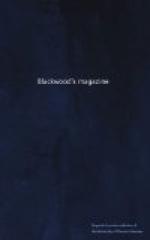guineas to Gainsborough, who asked sixty, for his
“Girl and Pigs,” thus—“Reynolds
was commonly humane and tolerant; he could indeed
afford, both in fame and purse, to commend and aid
the timid and needy.”—P. 304.
This is qualifying vilely a generous action, while
it contradicts his assertion of being sparing of “a
kindly word and a guinea.” Nor are the
occasional criticisms on passages in the “Discourses”
in a better spirit, nor are they exempt from a vulgar
taste as to views of art; their sole object is, apparently,
to depreciate Reynolds; and though a selection of
individual sentences might be picked out, as in defence,
of an entirely laudatory character, they are contradicted
by others, and especially by the sarcastic tone of
the Life, taken as a whole. But it is not only
in the Life of Reynolds that this attempt is made
to depreciate him. In his “Lives”
of Wilson and Gainsborough, he steps out of his way
to throw his abominable sarcasm upon Reynolds.
One of many passages in Wilson’s Life says, “It
is reported that Reynolds relaxed his hostility at
last, and, becoming generous when it was too late,
obtained an order from a nobleman for two landscapes
at a proper price.” So he insinuates an
unworthy hypocrisy, while lauding the bluntness of
Wilson. “Such was the blunt honesty of
his (Wilson’s) nature, that, when drawings were
shown him which he disliked, he disdained, or was
unable to give a courtly answer, and made many of
the students his enemies. Reynolds had the sagacity
to escape from such difficulties, by looking at the
drawings and saying ’Pretty, pretty,’
which vanity invariably explained into a compliment.”—P.
207. After having thus spoken shamefully of Sir
Joshua Reynolds in the body of his work, he reiterates
all in a note, confirming all as his not hasty but
deliberate opinion, having “now again gone over
the narrative very carefully, and found it impossible,
without violating the truth, to make any alteration
of importance as to its facts;” and though he
has omitted so much which might have been given to
the honour of Reynolds, he is “unconscious of
having omitted any enquiry likely to lead him aright.”—P.
320. He may have made the enquiry without using
the information—a practice not inconsistent
in such a biographer. For instance, when he assumes,
that in the portrait of Beattie, the figures of Scepticism,
Sophistry, and Infidelity, represent Hume, Voltaire,
and Gibbon; remarking, that they have survived the
“insult of Reynolds.” An enquiry
from Northcote ought to have led him to conclude otherwise,
for Northcote, who had the best means of knowing,
says, “Because one of those figures was a lean
figure, (alluding to the subordinate ones introduced,)
and the other a fat one, people of lively imaginations
pleased themselves with finding in them the portraits
of Voltaire and Hume. But Sir Joshua, I have
reason to believe, had no such thought when he painted
those figures.” We have done with this disgusting
Life. We would preserve to art and the virtue-loving




